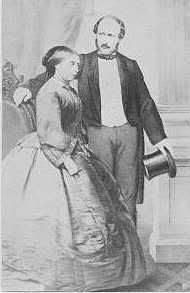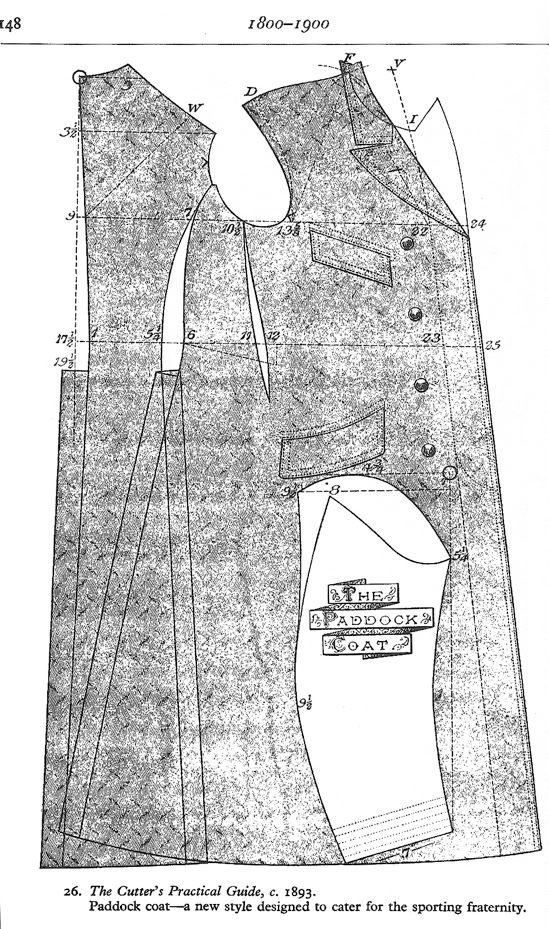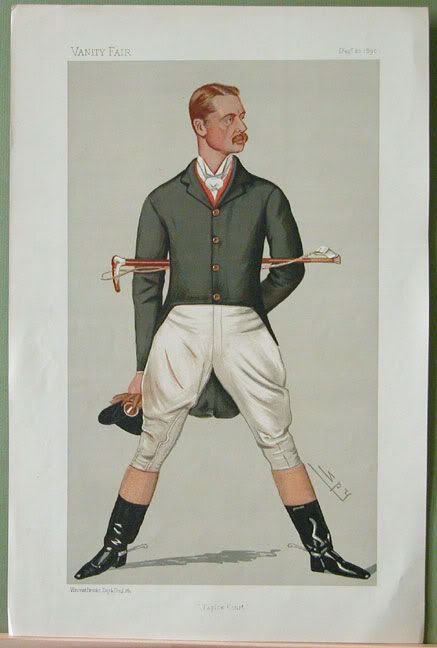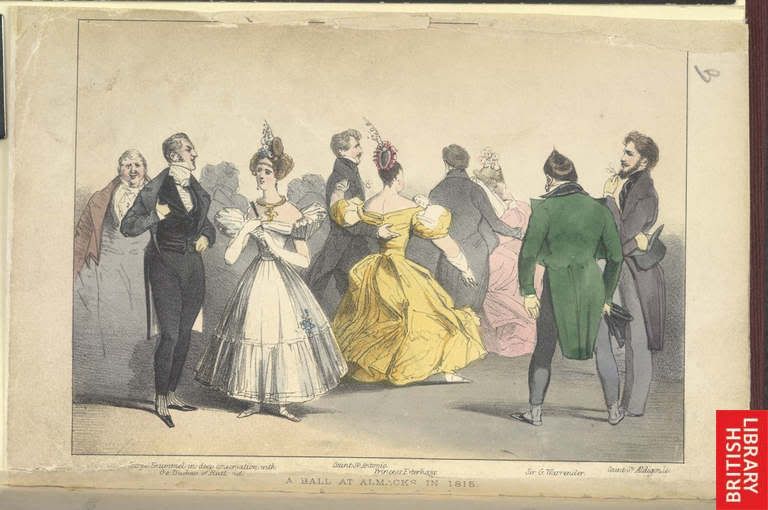The Frock Overcoat
Sator, thank you very much for the detailed answer.
Now I understand the confusion with the names. I just wonder that perhaps by the 1930s the frock overcoat/surtout had become so rare that maybe it's american term (especially because it was America were terminology changed the most) changed into 'paddock coat' by the time of the magazine's publication. Or maybe it was just a mistake, I just say it might be possible.
I agree about the characteristics of the frock overcoat, the coat of the illustration is definitely a frock overcoat. I guess I was confused by the velvet collar and the strange buttoning, v-front (I know some frock coats were v-buttoned, but it was not as common as straight buttoning, right?) and the closeness of the buttons, there are so near to each other (in the vertical axis) and so far in the horizontal, it seemed like a strange buttoning style.
Thanks again for the explenation.
Now I understand the confusion with the names. I just wonder that perhaps by the 1930s the frock overcoat/surtout had become so rare that maybe it's american term (especially because it was America were terminology changed the most) changed into 'paddock coat' by the time of the magazine's publication. Or maybe it was just a mistake, I just say it might be possible.
I agree about the characteristics of the frock overcoat, the coat of the illustration is definitely a frock overcoat. I guess I was confused by the velvet collar and the strange buttoning, v-front (I know some frock coats were v-buttoned, but it was not as common as straight buttoning, right?) and the closeness of the buttons, there are so near to each other (in the vertical axis) and so far in the horizontal, it seemed like a strange buttoning style.
Thanks again for the explenation.
-
storeynicholas
Dear Sator,
Thank you for these images. Is there, though, anything which shows a named person in a black tie and full evening coat? I am not surprised that images exist but these, if I may say so, seem a little vague in provenance. For my money, the prescriptions of alternative Court Dress provide the clearest clues as to the prescription of the components of full evening dress (at least for the UK) and none that I have seen mentions black tie at all just white - although the codes were specific enough to prescribe the number and colour of hknee buttons on evening breeches and the acceptability of dark or white w/c.
NJS
Thank you for these images. Is there, though, anything which shows a named person in a black tie and full evening coat? I am not surprised that images exist but these, if I may say so, seem a little vague in provenance. For my money, the prescriptions of alternative Court Dress provide the clearest clues as to the prescription of the components of full evening dress (at least for the UK) and none that I have seen mentions black tie at all just white - although the codes were specific enough to prescribe the number and colour of hknee buttons on evening breeches and the acceptability of dark or white w/c.
NJS
Voilà Prince Albert:storeynicholas wrote: Is there, though, anything which shows a named person in a black tie and full evening coat?

Actually fascinatingly counter intuitively, au contraire - it is in America that the language has sometimes remained less changed. The word Tuxedo is older than "dinner jacket" which used to be called a "dress lounge". Suspenders are an older word for the modern British English "braces". "Cutaway" too is an older word for a "morning coat". However, "surtout" was originally half overcoat, half undercoat but ended up an undercoat in British English and an overcoat in American English! Such is language.Guille wrote: Now I understand the confusion with the names. I just wonder that perhaps by the 1930s the frock overcoat/surtout had become so rare that maybe it's american term (especially because it was America were terminology changed the most) changed into 'paddock coat' by the time of the magazine's publication. Or maybe it was just a mistake, I just say it might be possible.
Here BTW is a pattern from c.1893 for a "paddock coat":

I think this shows how someone unfamiliar with the frock overcoat/surtout in the AA/Esky picture might have pondered what this old fashioned double breasted body coat was called by older gentlemen and could erroneously leap to the conclusion that it was just such a "paddock coat". None of the editors obviously knew any better - or perhaps they didn't have access to the images at the time of reading the text. Who knows?
Whatever the case, they have left a legacy following on from which it has taken quite a bit of research to untangle the fine mess.
Generally true. Even (in areas less touched by one or more of our continuing waves of immigrants) our accents remain closer to those of seventeenth-century England than, probably, any place in England (remember Cecil Sharp's and others' researches into early-twentieth-century Appalachia). Language often changes little, and sometimes (witness the collapse of the Roman Empire in the West) all too rapidly.Sator wrote:Actually[,] . . . it is in America that the language has sometimes remained less changed. . . .
As an aside, I think I dimly recall hearing, in my childhood (and I was born in the 1950s), a Vermont Yankee (that appellation now itself an anomaly, as three-quarters or more of the million souls in the state have recently come from elsewhere) call a silver quarter-dollar coin a "shilling": it was, it's true, about the size of the silver shilling coined before the Revolution (at the beginning of which, the pound sterling was valued at about five dollars, making the shilling roughly equal in value to a quarter of a dollar); but shillings have not been current in New England since 1775!
In the American South, a "planter's tie". I've also heard it called, somewhat confusedly, a "string tie".Sator wrote:. . . . I wish I knew what that thin, somewhat longer bow tie was called. . . .
-
storeynicholas
Dear Sator,Sator wrote:Voilà Prince Albert:storeynicholas wrote: Is there, though, anything which shows a named person in a black tie and full evening coat?
I fear that I do not accept that the Prince Consort is in evening dress in the picture which you have found. First, the Queen is not (she's in a plain day dress) and, secondly, compare this picture, below, of 1860, of him in evening dress:

Even if he did not always wear all his decorations, he would not have worn light trousers and he would have had gloves. The picture which you adduce shows him in a cut of coat which was, at least by the early 19th century, common daywear and indeed endures even now, as a dressage coat in certain equestrian events - although, otherwise, now the cut is reserved for full evening dress. Here is an early 20th century version of the swallow-tail coat as a form of daywear, on William Henry Grenfell:
[/img][/img]

NJS
You could be right about the Prince Consort. However, I know not a thing about women's evening dress conventions of the period. Only that by the time Albert married Victoria, dress coats had become rather rare as daywear. He could well be wearing white gloves in that portrait. Dress coats have waist seam pockets anyway where the gloves may be stored away. Is he wearing contrasting coloured trousers? Possible, but it could also be the play of light. There is also the older convention of wearing non-matching trousers for evening dress:

Notice the black cravat. The book I got it off claims it to be "evening wear" but notice the "Mode del Giorno" - giorno can mean morning! Does it mean morning dress or the style of the day? It could mean either. They are at the opera.
Here is Lizzy being presented to Mr Darcy in an original period illustration wearing non-matching pantaloons:

I also have a painting by Ludwig Marold, "Salonstueck", 1896 with two men in dress coats and pumps with black ties and white waistcoats. The ladies are in fine silks and have fans. The fact they are in a salon suggests evening dress.
All of the original 1830 Magazine of Fashion plates are unanimous in showing daywear with black neckwear and eveningwear in white neckwear.
Portraits in evening dress are somewhat uncommon. Most painters seemed to prefer not to work in the evenings (oddly enough). However, I have quite a few sources with pictures of evening full dress with a black tie. I also found a dinner jacket worn with a white tie.

Notice the black cravat. The book I got it off claims it to be "evening wear" but notice the "Mode del Giorno" - giorno can mean morning! Does it mean morning dress or the style of the day? It could mean either. They are at the opera.
Here is Lizzy being presented to Mr Darcy in an original period illustration wearing non-matching pantaloons:

I also have a painting by Ludwig Marold, "Salonstueck", 1896 with two men in dress coats and pumps with black ties and white waistcoats. The ladies are in fine silks and have fans. The fact they are in a salon suggests evening dress.
All of the original 1830 Magazine of Fashion plates are unanimous in showing daywear with black neckwear and eveningwear in white neckwear.
Portraits in evening dress are somewhat uncommon. Most painters seemed to prefer not to work in the evenings (oddly enough). However, I have quite a few sources with pictures of evening full dress with a black tie. I also found a dinner jacket worn with a white tie.
-
storeynicholas
Sator, I'd like to get my hands on your collection of illustrative materials!  and thank you for sharing them. I certainly accept that DJ and white tie and white vest is uncontentious (although might now cause a stir). I too, know little of women's fashions at all but do know that evening dresses for most of the age from 1800, anyway, have been sleeveless (or just about) and normally with some decolletage; indeed, the picture that you have found from Pride and Prejudice shows an example, which is in stark contrast with Victoria's dress in the Albert and Victoria picture.
and thank you for sharing them. I certainly accept that DJ and white tie and white vest is uncontentious (although might now cause a stir). I too, know little of women's fashions at all but do know that evening dresses for most of the age from 1800, anyway, have been sleeveless (or just about) and normally with some decolletage; indeed, the picture that you have found from Pride and Prejudice shows an example, which is in stark contrast with Victoria's dress in the Albert and Victoria picture.
I also accept that evening breeches, pantaloons and then trousers have, sometimes, been in a different colours from the coat - even up to around 1883 (at least), there are descriptions of midnight blue coats and black breeches. Indeed, at first, they were often different colours. So far as the day use of the swallow-tail coat goes - In 1840, Lord Palmerston was drawn in day dress (holding papers), in a swallow-tail coat (following image). The picture of Victoria and Albert is even later, as he has lost a good deal of hair, but I would suggest that it is more likely than not, overall, that that was a day dress picture.

On pockets in such coats - by 1986 they certainly just had tail pockets and inside breast pockets and you may well be quite right about the 19th century versions: I'm certainly not going to argue on that with a man who possesses your archive of patterns (although I should be interested to see how waistline pockets would fit in). On the Italian engraving - the chap on the right looks as though he is in evening dress and the other looks, to me, as though he has pitched up in day dress but, as you say, who knows the true intention behind the caption!
(although I should be interested to see how waistline pockets would fit in). On the Italian engraving - the chap on the right looks as though he is in evening dress and the other looks, to me, as though he has pitched up in day dress but, as you say, who knows the true intention behind the caption!
Here is an 1815 engraving of Brummell standing at front, far left with Lady Jersey at Almack's - and he has a midnight blue coat, white cravat, dark vest, black pantaloons (by then an acceptable alternative to knee breeches), striped stockings and pumps. As the events started at 11pm - we can note that various coat and pantaloon colours were still being worn by men in the evenings. When, towards the end of his life but before the Asylum claimed Brummell, Armstrong and his other friends would no longer allow him white cravats even in the daytime, he became very gloomy:
[/img]
The smoking jacket precursor of the DJ which Henry Poole made for the then PoW was made in 1860 and it might have been between then and 1886 that the style started to be popularized and an overall clearer distinction between white tie for full fig and black for DJ started to appear. However, all definite examples of 19th century British full evening dress, which I have seen, would suggest that white tie was, at least, much more usual in Britain. I simply cannot speak about other places because they might well have had variations and of course, I cannot say that no one wore a black tie with full fig. However, would you contend that it has not all settled down now to the point that:
black tie with a full dress coat would be an error;
dark vest with a full dress coat would be unusual but not an error (noting the Duke of Windsor's outfit, from 1938, with replacement trousers made in 1965), and
white tie and vest with a DJ would also be unusual but not erroneous?
NJS[/img]
I also accept that evening breeches, pantaloons and then trousers have, sometimes, been in a different colours from the coat - even up to around 1883 (at least), there are descriptions of midnight blue coats and black breeches. Indeed, at first, they were often different colours. So far as the day use of the swallow-tail coat goes - In 1840, Lord Palmerston was drawn in day dress (holding papers), in a swallow-tail coat (following image). The picture of Victoria and Albert is even later, as he has lost a good deal of hair, but I would suggest that it is more likely than not, overall, that that was a day dress picture.

On pockets in such coats - by 1986 they certainly just had tail pockets and inside breast pockets and you may well be quite right about the 19th century versions: I'm certainly not going to argue on that with a man who possesses your archive of patterns
Here is an 1815 engraving of Brummell standing at front, far left with Lady Jersey at Almack's - and he has a midnight blue coat, white cravat, dark vest, black pantaloons (by then an acceptable alternative to knee breeches), striped stockings and pumps. As the events started at 11pm - we can note that various coat and pantaloon colours were still being worn by men in the evenings. When, towards the end of his life but before the Asylum claimed Brummell, Armstrong and his other friends would no longer allow him white cravats even in the daytime, he became very gloomy:
[/img]

The smoking jacket precursor of the DJ which Henry Poole made for the then PoW was made in 1860 and it might have been between then and 1886 that the style started to be popularized and an overall clearer distinction between white tie for full fig and black for DJ started to appear. However, all definite examples of 19th century British full evening dress, which I have seen, would suggest that white tie was, at least, much more usual in Britain. I simply cannot speak about other places because they might well have had variations and of course, I cannot say that no one wore a black tie with full fig. However, would you contend that it has not all settled down now to the point that:
black tie with a full dress coat would be an error;
dark vest with a full dress coat would be unusual but not an error (noting the Duke of Windsor's outfit, from 1938, with replacement trousers made in 1965), and
white tie and vest with a DJ would also be unusual but not erroneous?
NJS[/img]
-
Frog in Suit
- Posts: 452
- Joined: Tue Mar 27, 2007 9:42 pm
- Contact:
Dear all,
I may be nitpicking and I may be wrong, but the Pride and Prejudice illustration does not, at least to my inexpert eye, appear to be contemporary with the novel (1817).
I would have placed it much later in the century, perhaps even in the early XXth. Only compare it with the Brummell at Almack's 1815 picture, or the later (1849) fashion plate. Could the date below the unfortunately illegible signature be 1875?
I am not arguing on the basis of dress styles ( I know far too little about that), but on the depiction of the figures, especially the faces. What, may I ask, is the source?
Frog in Suit
I may be nitpicking and I may be wrong, but the Pride and Prejudice illustration does not, at least to my inexpert eye, appear to be contemporary with the novel (1817).
I would have placed it much later in the century, perhaps even in the early XXth. Only compare it with the Brummell at Almack's 1815 picture, or the later (1849) fashion plate. Could the date below the unfortunately illegible signature be 1875?
I am not arguing on the basis of dress styles ( I know far too little about that), but on the depiction of the figures, especially the faces. What, may I ask, is the source?
Frog in Suit
Dear Frog,
I read the date as 1870 (the top bar of a would-be "5" is, I think, simply a swash to balance the one beneath "18" to the left); and the style of illustration strikes me as more plausibly from the 1880s or '90s. Clearly, whatever the date, the illustration is not contemporary with the novel. Perhaps Sator intended "period" to indicate that the illustration is not contemporaneous with us!
Yours,
RWS
I read the date as 1870 (the top bar of a would-be "5" is, I think, simply a swash to balance the one beneath "18" to the left); and the style of illustration strikes me as more plausibly from the 1880s or '90s. Clearly, whatever the date, the illustration is not contemporary with the novel. Perhaps Sator intended "period" to indicate that the illustration is not contemporaneous with us!
Yours,
RWS
-
Frog in Suit
- Posts: 452
- Joined: Tue Mar 27, 2007 9:42 pm
- Contact:
Dear RWS,
Thank you for your support. I am sure your opinion is based on knowledge, rather than only an impression, like mine.
Another quibble: Nowhere in the book does Mr Bennett (as I presume it is he whom the older man in the middle is meant to represent) utter the sentence :"Mr. Darcy, you must allow me to present this young lady to you as a very desirable partner." It would be patently absurd to have a woman introduced to a man, rather than the other way around.
Frog in Suit
Thank you for your support. I am sure your opinion is based on knowledge, rather than only an impression, like mine.
Another quibble: Nowhere in the book does Mr Bennett (as I presume it is he whom the older man in the middle is meant to represent) utter the sentence :"Mr. Darcy, you must allow me to present this young lady to you as a very desirable partner." It would be patently absurd to have a woman introduced to a man, rather than the other way around.
Frog in Suit
Thank you, dear Frog, for confirming what I had thought: the sentence captioning the colored sketch nowhere appears in the text of the novel. Not having read the book in -- what? more than a third of a century? -- and not having a copy readily to hand, I'd hesitate to remark upon the oddity.
And, true, save to the sovereign, perhaps, a gentlewoman would not have been presented to a young man in Jane Austen's England! Perhaps this phantasmic exchange was intended to represent a reintroduction.
And, true, save to the sovereign, perhaps, a gentlewoman would not have been presented to a young man in Jane Austen's England! Perhaps this phantasmic exchange was intended to represent a reintroduction.
I believe the gentleman introducing the future bride and groom to each other is not Mr Bennet, but the local mayor at the ball where they first meet. I, too, don't have a copy of the novel at hand, neither do I recall his name except that he is sir something - and so obsessed with courteous behaviour that he makes a number of social faux pas, of which the remark Frog in Suit frowns upon would be just another one.
Milo
Milo
Whatever the provenance or the errors incorporated in it, though, I do (as one less than happily unmarried) rather like the picture.
-
- Information
-
Who is online
Users browsing this forum: No registered users and 31 guests
